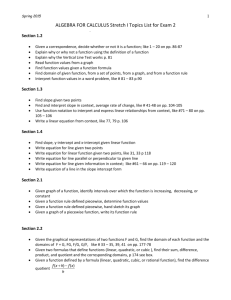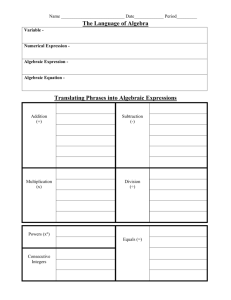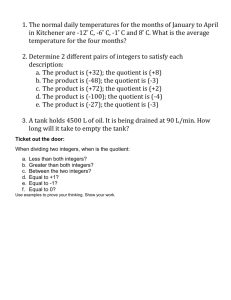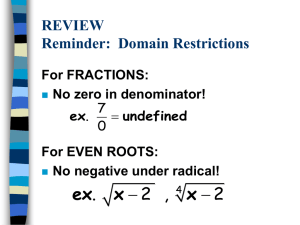1.4 Notes (Completed) - Fort Thomas Independent Schools
advertisement
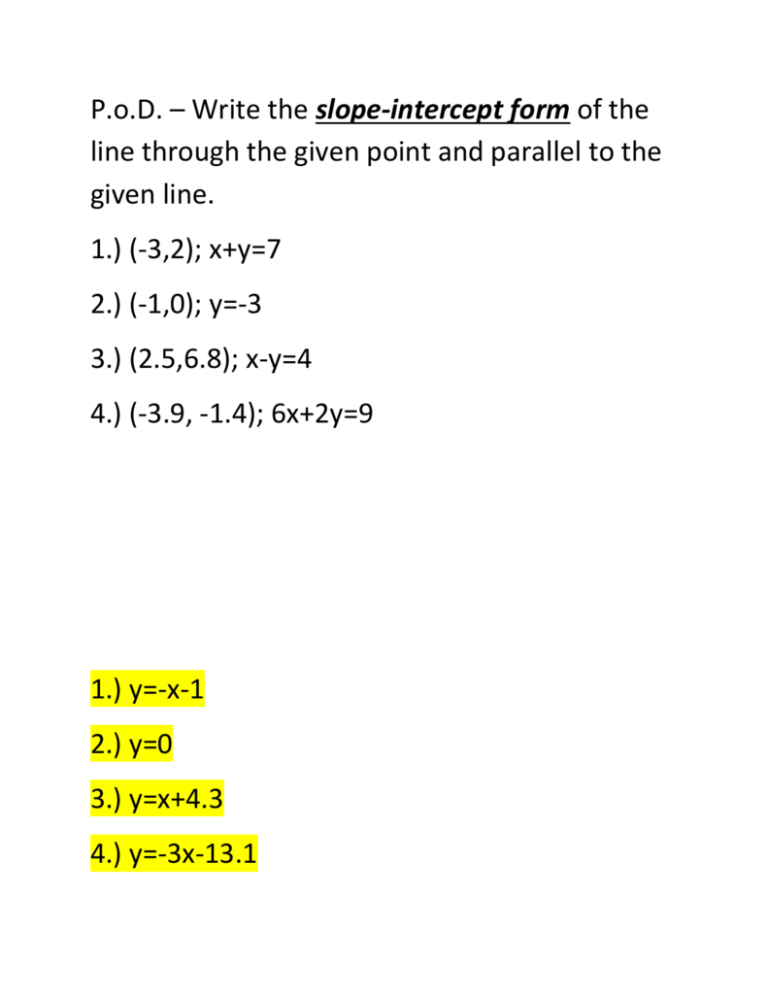
P.o.D. – Write the slope-intercept form of the
line through the given point and parallel to the
given line.
1.) (-3,2); x+y=7
2.) (-1,0); y=-3
3.) (2.5,6.8); x-y=4
4.) (-3.9, -1.4); 6x+2y=9
1.) y=-x-1
2.) y=0
3.) y=x+4.3
4.) y=-3x-13.1
1.4 – Functions
Learning Target(s): I can determine whether
relations between two variables are functions;
use function notation and evaluate functions;
find the domain of functions; use functions to
solve real-life problems; evaluate the difference
quotient.
Relation – a set of ordered pairs.
Function – a relation where each element in
the domain is paired with exactly one element
in the range.
EX: Let A={2,3,4,5} and B={-3, -2, -1, 0, 1}.
Which of the following sets of ordered pairs
represents functions from set A to set B?
a.) {(2,-2), (3,0), (4,1), (5,-1)}
Since no items in the domain repeat, this IS a
function.
b.) {(4,-3), (2,0), (5,-2), (3,1), (2,-1)}
Since x=2 is mapped to two elements in the
range, this is NOT a function.
c.) {(2,-1), (3,-1), (4,-1), (5,-1)}
Since no items in the domain repeat, this IS a
function.
d.) {(3,-2), (5,0), (2,-3)}
Since 4 was in our original set and it is not
included in this grouping, this is NOT a function.
Domain – set of all “x” values; first coordinates;
inputs; independent variable; abscissa;
argument
Range – set of all “y” values; second
coordinates; outputs; dependent variable;
ordinate; value
http://www.youtube.com/watch?v=Uz0MtFlLD-k
EX: Determine whether the equation 𝑥 2 +
𝑦 2 = 8 represents y as a function of x.
Begin by solving for y.
𝑦2 = 8 − 𝑥2
𝑦 = ± √8 − 𝑥 2
Substitute 2 in for x.
𝑦 = ±√8 − 22 = ±√8 − 4 = ±√4 = ±2
Now consider the ordered pairs (2,2) and (2,-2).
Since x=2 is mapped to both 2 and -2, this is
NOT a function.
Next, let’s examine this solution graphically.
If we recall from previous courses, this does
NOT pass the Vertical Line Test, so it is NOT a
function.
Vertical Line Test:
If a vertical line crosses the graph in two or
more places, then the graph is NOT a function.
Types of Notation:
Normal
Y=3x+4
Function
f(x)=3x+4
Mapping
f:x 3x+4
EX: Let 𝑓 (𝑥) = 10 − 3𝑥 2 and find the
following:
a.) f(2)
𝑓(2) = 10 − 3(2)2 = 10 − 3(4) = 10 − 12
= −2
b.) 𝑓(−4)
𝑓(−4) = 10 − 3(−4)2 = 10 − 3(16)
= 10 − 48 = −38
c.) f(x-1)
𝑓 (𝑥 − 1) = 10 − 3(𝑥 − 1)2
= 10 − 3(𝑥 − 1)(𝑥 − 1)
= 10 − 3(𝑥 2 − 𝑥 − 𝑥 + 1)
= 10 − 3(𝑥 2 − 2𝑥 + 1)
= 10 − 3𝑥 2 + 6𝑥 − 3
= −3𝑥 2 + 6𝑥 + 7
Piecewise Function – a function that is defined
in parts.
EX: Evaluate the function 𝑓 (𝑥) =
3𝑥 − 4, 𝑥 < 0
{
, when x=-2,0, and 2.
3𝑥 + 1, 𝑥 ≥ 0
f(-2)=3(-2)-4=-6-4=-10
f(0)=3(0)+1=0+1=1
f(2)=3(2)+1=6+1=7
Recall, domain is all possible “x” values.
http://www.youtube.com/watch?v=4Y1xO5squ8M
EX: Find the domain of 𝑔(𝑥) = √𝑥 − 16
What do we NOT want under a radical?
A negative number.
Therefore, our domain is x-16>0.
Domain: x>16
*Show how to find domain using the TABLE on
the graphing calculator.
EX: For a cone, the ratio of its height to its
radius is 3. Express the volume of the cone, 𝑉 =
1
𝜋𝑟 2 ℎ,
3
as a function of the radius r.
h=3r
1 2
𝑉 = 𝜋𝑟 (3𝑟) =
3
𝜋𝑟 3
EX: A baseball is hit at a point 3 feet above the
ground at a velocity of 100 feet per second and
an angle of 45 degrees. The path of the baseball
is given by 𝑦 = −0.0032𝑥 2 + 𝑥 + 3, where x
and y are measured in feet. Will the baseball
clear a 20 foot fence located 280 feet from
home plate?
X=distance, y=height
𝑦 = −0.0032(280)2 + (280) + 3 =
32.12𝑓𝑡
Yes, the ball will clear the fence.
EX: The total value V (in billions of dollars) of
farm real estate in the United States from 1980
through 1997 can be approximated by the
model 𝑉(𝑡) =
−13.836𝑡 2 + 59.96𝑡 + 775.4,0 ≤ 𝑡 ≤ 6
{
382.4 + 28.7𝑡, 7 ≤ 𝑡 ≤ 17
where t=0 represents 1980. Use this model to
approximate the total value of farm real estate
in 1982, 1987, and 1996.
𝑓(2) = −13.836(2)2 + 59.96(2) + 775.4
= $839.98
𝑓 (7) = 382.4 + 28.7(7) = $583.3
𝑓 (16) = 382.4 + 28.7(16) =$841.6
Difference Quotient – your first introduction to
Calculus; used to find a derivative (you’ll learn
more about that later)
EX: For 𝑓(𝑥) = 𝑥 2 − 2𝑥 + 9, find
𝑓 (4+ℎ )−𝑓(4)
ℎ
where ℎ ≠ 0.
[(4 + ℎ)2 − 2(4 + ℎ) + 9] − [42 − 2(4) + 9]
ℎ
[16 + 8ℎ + ℎ2 − 8 − 2ℎ + 9] − [16 − 8 + 9]
=
ℎ
[ℎ2 + 6ℎ + 17] − [17]
=
=
ℎ
ℎ2 + 6ℎ
=
ℎ
ℎ+6
http://www.youtube.com/watch?v=OXXrsxA4f_4
EX: For 𝑓(𝑥) =
4𝑥 2
− 2𝑥, find
𝑓 (𝑥+ℎ)−𝑓(𝑥)
.
ℎ
[4(𝑥 + ℎ)2 − 2(𝑥 + ℎ)] − [4𝑥 2 − 2𝑥]
ℎ
[4(𝑥 2 + 2ℎ𝑥 + ℎ2 ) − 2𝑥 − 2ℎ] − 4𝑥 2 + 2𝑥
=
ℎ
[4𝑥 2 + 8ℎ𝑥 + 4ℎ2 − 2𝑥 − 2ℎ] − 4𝑥 2 + 2𝑥
=
ℎ
8ℎ𝑥 + 4ℎ2 − 2ℎ
=
ℎ
= 8𝑥 + 4ℎ − 2
Upon completion of this lesson, you should be
able to:
1. differentiate between domain and
range
2.
3.
graph piecewise functions
use the difference quotient
For more information on piecewise graphs, visit
https://www.youtube.com/watch?v=hy0N-90gCu0
For more information on the difference
quotient, visit
https://www.coastal.edu/mathcenter/HelpPages/Difference%20Quotient/sld001.htm
HW
116
Pg.48 6-69 3rds, 80-86E, 89, 92, 109-


